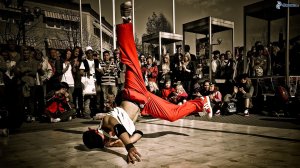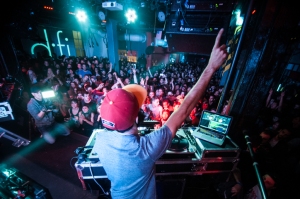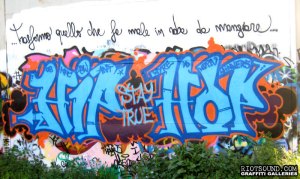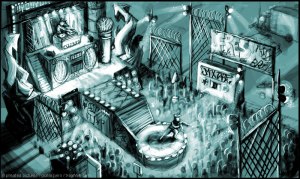“Keep in mind when brothas start flexing the verbal skillz,
it always reflects what’s going on politically, socially,
and economically.” –Musician Davey D
This blog will enlighten its readers on a genre with humble beginnings, but whose reach and popularity have arguably surpassed all of the rest. This, ladies and gentlemen, is the (r)evolution of hip-hop.
Before we can truly discuss the genre, we will clarify another debate: the difference between rap and hip-hop. Rap itself originated as a local, insular genre in the late 70s among blacks and Hispanics in New York. Hip Hop has been thought of as a cultural movement rendered in the form of dress, gestures and language that embody urban street consciousness. The term hip-hop specifically refers to the movement that occurred in the late 1980s and 1990s, which is when the genre reached international commercial success (Shuker). It is identified by 4 key elements:
Photo credit: www.wallpaperup.com
Break dancing: A distinctive style of dance practiced by B-boys & B-girls.(Physical)
Photo credit: www.redbullthre3style.com
Disk Jockying/DJing: Spinning, mixing, scratching records in a public setting. (Aural)
Graffiti Art: Visual
Photo credit: www.tragnark.com
Emceeing: Mcing, Or ‘Rapping’ (Oral)
Two different types of Mcing or ‘Rapping’ – A Rap Battle, and Raw Bars
History
1900s – 1920s
Paul Gilroy has described the origins of hip-hop as a “cross fertilization of African American vernacular cultures with Caribbean equivalents”. This definition seems fitting, as the genre’s origins lay in the West African Barak music and dance styles which were adopted by African American slaves. They used poetic renderings in the form of performed sermons, girls’ game songs, as well as ritualized songs called ‘dozens’ or ‘snaps’ where two people dueled in rhymes about their mothers or relatives. These techniques were later used in the toast known as “The Signifyin’ Monkey”, including repetition, mimicry, metaphor, exaggeration, humor and above all, signification or ‘signifyin’.
As African American slaves migrated to Northern cities, they brought their traditions along with them. Southern vernacularism evolved as an urban way of speaking, characterized by giving words an alternative meaning (eg. Using the word crib for abode). This re-contextualization of English words to give meaning for African Americans in an urban environment came to be known as ‘Jive talk’.
1940s – 1950s
Jive talk became part of the be-bopp jazz culture, as well as some blues [eg. Louis Jordan uses jive in “Saturday Night Fish Fry”]. It is also popularized by black DJ’s such as Holmes Daddy-O-Dailey of WAIT radio in Chicago. Black comedians also add to the popularity of this form of talk, with figures such as Rudy Ray Moore using it in “The Signifyin Monkey” and Redd Foxx in his act. Boxer Mohammed Ali also used jive rhymes to instill fear in his opponents with rhyming couplets about his athleticism and elitism.
1960s
In the 1960s, we see a shift from jive talk to rapping, attributed to Black Nationalist figure Hubert or H. ‘Rap’ Brown, whose nickname acknowledges his mastery of urban street speech. A turning point occurs in 1965 with the death of Black Nationalist leader Malcom X, which leads to the Black Arts Movement (BAM). Artists use rappin’ style (metaphor, word alliteration, repetition, breath cadences, heightened speech, black vernacular street speech) along with African percussion to address the issues that most concerned the African American community. Great emphasis is put on self-pride and self-definition. This is poetry with a socio-economic, political tone. Popular poets met at writers’ workshops in NY and LA; among these were Nikki Giovanni, Don Lee and Larry Neal. These were among the first to be recognized through their spoken word tours and sound recordings.
Simultaneously, King Tubby discovers a way of fading out vocal and instrumental parts of the 2-track recording machine, creating ‘dub versions’ (or several varied cuts from the original
1970s
In the 1970s, rapping is accompanied by toasting – a style that originated from Jamaica (Shuker) that used patois over recorded or dub versions, called talk overs.
In 1973, Jalal ‘Lightnin’ Rod Urdin recorded a solo album called Hustler’s Convention, where he spins toast-like tales about the exploitation of two urban characters: Sport ‘The Gambler and ‘Spoon’. The association with street wisdom, black hyper masculinity and jive talk make this the first prototype of ‘gangsta’ reality rap.
1970s– Influences
Aside from the use of Jamaican toasters, the genre adopted its flare by incorporating stripped-down funk music (Shuker). To fully understand the ‘big picture’ of how this came to be, we must discuss the implications of another popular genre of the time: disco. Both disco and funk music were born after the Civil Rights Movement in the 1970s, when African American music became more ‘mainstream’.
Disco’s music basis was soul or gospel-style vocals, and used bass-drum rhythms that accented all 4 beats subdivided by hi-hat cymbals. In disco clubs and bars, DJ’s were used to spin tracks non-stop. Important figures in disco music include Barry White of 20th Century Records and the O’ Jays.
The birth of funk, on the other hand, has been attributed to James Brown. This genre is characterized by earthy, gritty sounds, interlocking horn and rhythm sections with groove lines – all accompanied by preachy vocals and grunts. It was a ‘sped up version of blues’, which is probably why it crossed over to mainstream charts. In the LA underground culture, “the Lockers” developed a robotic ‘locking’ dancing technique to accompany funk. The pop & lock moves were popularized when televised on SNL and the Carol Burnett Show. Meanwhile, in New York, dancers (breakers) were incorporating locking into their routines but also added upper torso and foot movements. These moves (up rocking and top rocking), along with headspins and backspins were punctuated with final freezing movements. Breakdancing, and hip hop culture, was taking shape.
The early 80s – Social Context
The development of hip-hop was shaped by the fact that disco became over-commercialized and New York kids preferred funk. But other geopolitical factors played a role in the evolvement of the genre. For example, the building of the Bronx Expressway which created disruption within the community. Coupled with post-industrial conditions and dwindling funds for inner-city and public arts programs, the Bronx witnesses a ‘white flight’. The majority of white people abandoned the area, leaving behind working class latinos and blacks. Suddenly, the Bronx saw an increase in crimes that spilled over to clubs.
Here, DJ’s used music as a way to control the crowd; eventually they took this strategy to streets, parks, and block parties.
Hip Hop Musical Traits
- A looped Instrumental incorporating any/all types or instruments and genres of music. This technique is known as ‘sampling’ where rappers borrowed other works to make music
- Re contextualization seen as a form of post-modern art (Shuker)
- May include string instruments, air instruments, even EDM & voices
- Instrumental is used as a canvas for lyrical expression, usually in rhyming form with a consistent sequence of ‘bars’
- A ‘hook’ or chorus is used in most songs, a common tool to embed a catchy element to help drive the song’s popularity
- Commonly, other artists are used for ‘the hook’, including fellow hip hop artists or r & b singers. Some artists have reached outside the genre, with examples such as Eminem using Aerosmith’s ‘Dream On’, Timbaland working with Elton John, or Ja Rule rapping alongside the harmonies of Ashanti
- Lyrics are usually telling a story, reciting experiences of the artist’s life; at times in a pompous, almost arrogant direction to help garner respect from both the idolizing audience as well as peers and/or competition in the genre
- Mature topics such as violence, sex, and drug use & distribution expressed the reality of most artists’ lives
Audience
- Initially was a solidaric one: fellow African Americans who were oppressed (especially post Black Arts Movement).
- Used the genre as a means of expression, to discuss the hardships, fellowships, and benefits of life in ‘the hood’ (‘gangsta rap’).
- Key move towards mainstream was when Run DMC collaborated with Aerosmith to release ‘Walk This Way’; symbolizing the merging of cultures and genres.
- Vanilla Ice, whose hit ‘Ice Ice Baby’ enjoyed massive success, became a martyr for middle and upper class suburban white fans to embrace and relate to the genre.
Race, Gender, Class, & Body
- While created within an African American subculture as a form, it has become a global subculture in latino, caucasian, and asian cultures.
- The genre began as a primarily male-dominated musical expression, but in the 1990’s began to include female artists such as Queen Latifah, Lauryn Hill, Lil’ Kim, & Missy Elliott
- Class, depicted within and throughout hiphop, is an interesting, polarized depiction of poverty and survival by any means, to the flashy allure of wealth; usually celebrating class mobility ‘starting from the bottom’.
- The ‘body’ of hip-hop culture is attributed to baggy clothing that doesn’t fit; attributed to ‘hand me downs’ from older siblings, and even an ideology of continual growth into the attire. It is a counter-sub culture, refusing to conform to the expectations of properly fitted clothing. Best symbolized by Kris Kross wearing their clothes backwards; a direct 180 degree refute to adhere to social norms.
- Heavy neck chains and bracelets symbolize the restraints throughout slavery, and a metaphor for the social restraints still incurred in present day society.
Authenticity
- Hip-hop has a self-governing barometer to dictate authenticity. It is gauged by artists’ musical depiction of their life, and its correlation to certain ‘codes’ of the street and approval amongst fellow artists within the culture of hip-hop.
- Raw, descriptive, honest depictions of life are seen as authentic, while simply using the medium as a means of showcasing the wealth and fame that the very expressive art brought the artists is seen as unauthentic, ‘selling out’, or simply ‘whack’.
- Examples of this can be traced back to the crossing over of the genre (when it was oppositional in nature, critique of poli-social issues) to mainstream, question of authenticity over conforming to what the masses prefer/what is most marketable (Shuker)
- Now rap IS the mainstream thanks to artists like Beyonce, Kanye west, Eminem that have reached huge record sales, endorsements etc. (Shuker)
References:
Horn, D. (2012). Hip Hop. In Continuum Encyclopedia of Popular Music of the World. (Vol. 8: North America, pp. 260-276). New York, NY: The Continuum International Publishing Group
Shuker, R. (2012). Understanding Popular Music Culture. New York, NY: Routledge
Blanchard, B. (1999, August 30). THE SOCIAL SIGNIFICANCE OF RAP & HIP-HOP CULTURE. Retrieved January 28, 2015, from https://web.stanford.edu/class/e297c/poverty_prejudice/mediarace/socialsignificance.htm
Hip hop. (Last update 2015, January 26). Retrieved January 30, 2015, from http://en.wikipedia.org/wiki/Hip_hop




A pretty insightful post on understanding the foundation of hip hop music, particularly rap. An interesting thing I’ve noticed about this genre of music, in relation to it’s audience, is how hip hop was used as a tool to express the hardships and struggles of life “in the hood.” Why this stands out to me is because hip hop music still plays homage to this, comparing to other genres such as alternative rock and indie, whose initial meanings behind its music has changed generationally. For example. you have new era artists like Drake and The Weeknd who still have influences of these concerns in their music, in the same style and manner as artists such as Tupac or Notorious B.I.G. many years prior. (For credit)
LikeLike